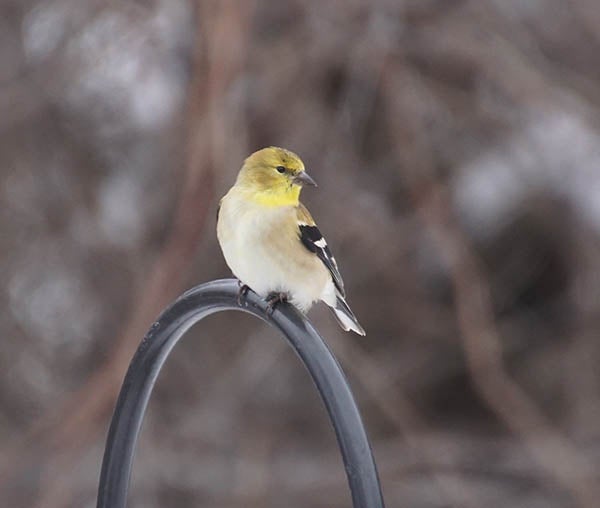What was the lowest temperature ever recorded in Minnesota?
Published 10:00 am Sunday, January 24, 2016
My neighbor Crandall stops by.
“How are you doing?” I ask.
“Everything is nearly copacetic. I had a bull mouse in the house. I trapped him, but nearly lost a finger in the process. I didn’t want to visit the hospital again. When I was a boy, I had an operation. They talked to Pop about anesthesia. He asked what that was. The doctor explained, ‘After your boy gets it, he won’t know a thing.’ Pop said to forget the anesthesia because ‘He don’t know nothing now.’ My old refrigerator is a goner. I’m emptying it by eating everything before its expiration date. I got one of those big bags of mixed nuts for the holidays —pecans, almonds, peanuts, walnuts and donuts, so I’m eating healthy. Pop is my inspiration. I’m trying not to be him when I grow up. Pop wears a sweatshirt as a scrapbook of the foods he’s eaten in the past week. I’m trying to shed some pounds. Remember when I jogged?”
“I do,” I say. “You gave it up when the walk back became too long.”
“I’m going to lose weight by a simple exercise. Whenever anyone offers me a snack, I’ll continue moving my head to the right and then to the left until the offer is rescinded.”
Nature by the yard
I hugged a tree.
Studies have shown that people who keep company with trees are more satisfied with their lives. A tree is a calming influence. Trees make us happy.
Q&A
“Do all birds have gizzards?” The gizzard is the muscular part of a bird’s stomach. When a bird eats, the food goes from the throat to the esophagus. Some species have an expanded, thin-walled pouch in the esophagus called the crop where food is stored before it’s sent to the stomach. All birds have two parts to their stomachs. The first is called the proventriculus or glandular stomach, where digestive enzymes are secreted to begin the digestion process. It’s similar to a human stomach. The second part is the gizzard. The gizzard is thick and muscular in some species, such as ducks, turkeys, chickens and grouse. These birds pick up grit that collects in the gizzard. That’s grit, not grits. Grit can be small stones, sand, etc. When food enters the gizzard, the grit helps pulverize it. All birds have a gizzard, but those that eat easily digested foods may have small, thin-walled gizzards.
“What is a birder’s idea of a good time?” I like 10:10 in the morning.
“Do birds have teeth?” A few species look as if they do, but they’re actually toothlike notches on their mandibles. They aren’t used to chew food. A developing chick inside an egg may have an egg tooth, a sharp projection on its upper bill. It’s not a true tooth. The chick uses the egg tooth to help break out of the egg. The egg tooth disappears in time.
“You mentioned gallinaceous birds on the radio. What are they?” Gallinaceous birds are heavy-bodied, ground-feeding birds, including chicken, grouse, ptarmigan, turkey, pheasant, quail, partridge, jungle fowl and chachalaca — all in the order Galliformes. They are mainly non-migratory birds.
“How do robins find worms?” By sight. A robin cocks its head to one side, using its eye to look for worms.
“What are zygodactyl feet?” Woodpeckers have zygodactyl feet, meaning they have two toes pointing forward and two toes pointing back. Most birds have three toes forward and one back. The two sets of opposing toes give woodpeckers a grip on surfaces.
“Are bats blind?” Bats have a well-developed eyesight, but they use echolocation to navigate and to find prey at night. They produce high-pitched sounds and listen to the sounds bouncing back, to determine the location of objects.
“How do animals survive our winters?” If you’re going to live here, you need a good plan. If you don’t have one, go to a window, because it’s curtains for you. If you stay here, you’d better be active, hibernate or go into torpor. You could migrate to that mysterious place called, “south.” You could avoid coming here at all or you could perish in the fall. It’s not a jungle out there, it’s much too cold.
“What is the coldest temperature ever recorded in Minnesota?” The state record low temperature in Minnesota was 60 degrees below zero recorded at Tower on Feb. 2, 1996. That is also the coldest temperature recorded east of the Mississippi River. The lowest temperature recorded in the United States was 80 degrees below zero on Jan. 23, 1971, at Prospect Creek Camp, located near the Arctic Circle along the Trans-Alaska Pipeline System. That isn’t much warmer than the 81.4 below zero record low for North America experienced at Snag in the Yukon on Feb. 3, 1947.
The Great Backyard Bird Count
The GBBC is a free, fun, and easy event that engages bird watchers of all ages. Participants are asked to count birds for as little as 15 minutes during the four-day event and report the sightings online at birdcount.org. More than 140,000 participants submitted their bird observations last year, creating the largest snapshot of global bird populations ever recorded. The 19th annual GBBC will be Feb. 12 through Feb. 15.
The International Festival of Owls
The 14th Annual International Festival of Owls takes place on March 4 through March 6 in Houston, Minnesota. The Illinois Raptor Center will be presenting live owl programs and plans on bringing 11 birds of six different species. There will be numerous speakers and programs.
Thanks for stopping by
“Learning too soon our limitations, we never learn our powers.” — Mignon McLaughlin
“It is better to walk alone than with a crowd going in the wrong direction.” — Diane Grant
Do good.
Al Batt of Hartland is a member of the Albert Lea Audubon Society. Email him at SnoEowl@aol.com.





